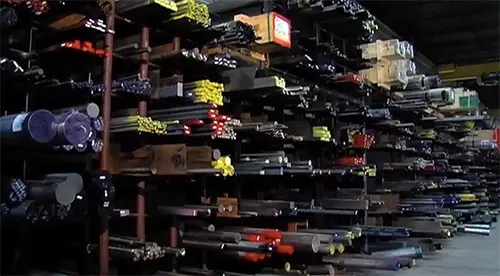High Speed Steel vs. Tungsten Steel

If you are searching for a highly heat- and wear-resistant steel, you may find yourself evaluating both high speed steel and tungsten steel. These two categories of steel alloys share some characteristics. You may have even heard of a type of steel referred to as tungsten high speed steel.
Understanding the specifics of these categories and their advantages and disadvantages will help you to find the right option for your application.
How High Speed Steel and Tungsten Steel Differ
HSS steel is a group of tool steel alloys that are characterized by high hardness, wear-resistance and heat-resistance. Typically, between 10% to 25% of HSS is made up of alloying elements including molybdenum, chromium, vanadium, cobalt and tungsten. There are numerous grades of HSS, each with different combinations and amounts of alloying elements.
The key advantage of HSS is that it can hold up to the significant heat and friction in high-speed tool applications.
Tungsten steel refers to any steel alloy that includes tungsten as an alloying element. This provides the steel with enhanced hardness, strength, wear resistance, toughness, heat resistance and corrosion resistance. In particular, the hardness and wear resistance continue even at temperatures exceeding 500 degrees Celsius.
Tungsten High Speed Steel
As the above information implies, there is some cross over between high speed steel and tungsten steel. Several HSS alloys including a significant amount of tungsten, conferring the impressive qualities of tungsten into the tool steel. These are sometimes referred to as tungsten high speed steel.
In some cases, high speed steel refers specifically to the molybdenum series of HSS. These alloys have between 3.75% and 10.5% molybdenum and 10% or less tungsten. Tungsten high speed steels have at least 12.38% tungsten and 1% or less molybdenum (T1 has no molybdenum). However, there are also some tungsten steels that are not classified as HSS.
How To Select the Right Steel for Your Needs
In general, the molybdenum series of HSS has better abrasion resistance than tungsten steel. When heat-treated, they are less likely to distort. In most cases, they are also less expensive than tungsten series alloys.
Conversely, tungsten high speed steel tends to have the best hot hardness of comparable alloys. Additionally, tungsten is very valuable for offering secondary hardness and resistance to tempering.
Typically, molybdenum HSS is used for cold work with high abrasion and very high speeds. Conversely, tungsten HSS is used for applications that will be at high heat. It is also sometimes used for cutting tool applications in which long service life is a high priority. However, T-series steels tend to be more expensive. So, a molybdenum HSS may be preferable in many cases.
Ultimately, the characteristics of the grade are often more important than those of the series. Therefore, it is important to examine the details of any alloy grade you are considering.
High Speed and Tungsten Steel Grades
There are a variety of high speed steel grades including molybdenum and tungsten series alloys. The M series options include M2, M3, M4, M7 and M42. The first three are tool steels with varying levels of carbon and vanadium. They offer well-balanced wear resistance and grindability. M7 and M42 are ideal for construction equipment and metal manufacturing, respectively.
Additionally, depending on your application, you may also want to consider PM M4 or PM M48. These are powdered metallurgy versions of molybdenum series alloys. They offer better tool life length compared to non-PM grades.
For tungsten high speed steel, we offer PM T15. This offers high wear resistance, impact toughness and bend strength.
Tungsten HSS Steel For Sale
- M2 – Rounds, flats, block, plate, hardened bar, tool bits
- M3 – Rounds, flats, block
- M4 – Rounds
- M7 – Rounds
- M42 – Rounds, flats, block, plate, hardened bar, tool bits
- PM M4 – Rounds, powdered metal sheets, block, plate
- PM M48 – Rounds, powdered metal sheets, block, plate, tool bits
- PM T15 – Rounds, powdered metal sheets, flats, block, plate, tool bits
